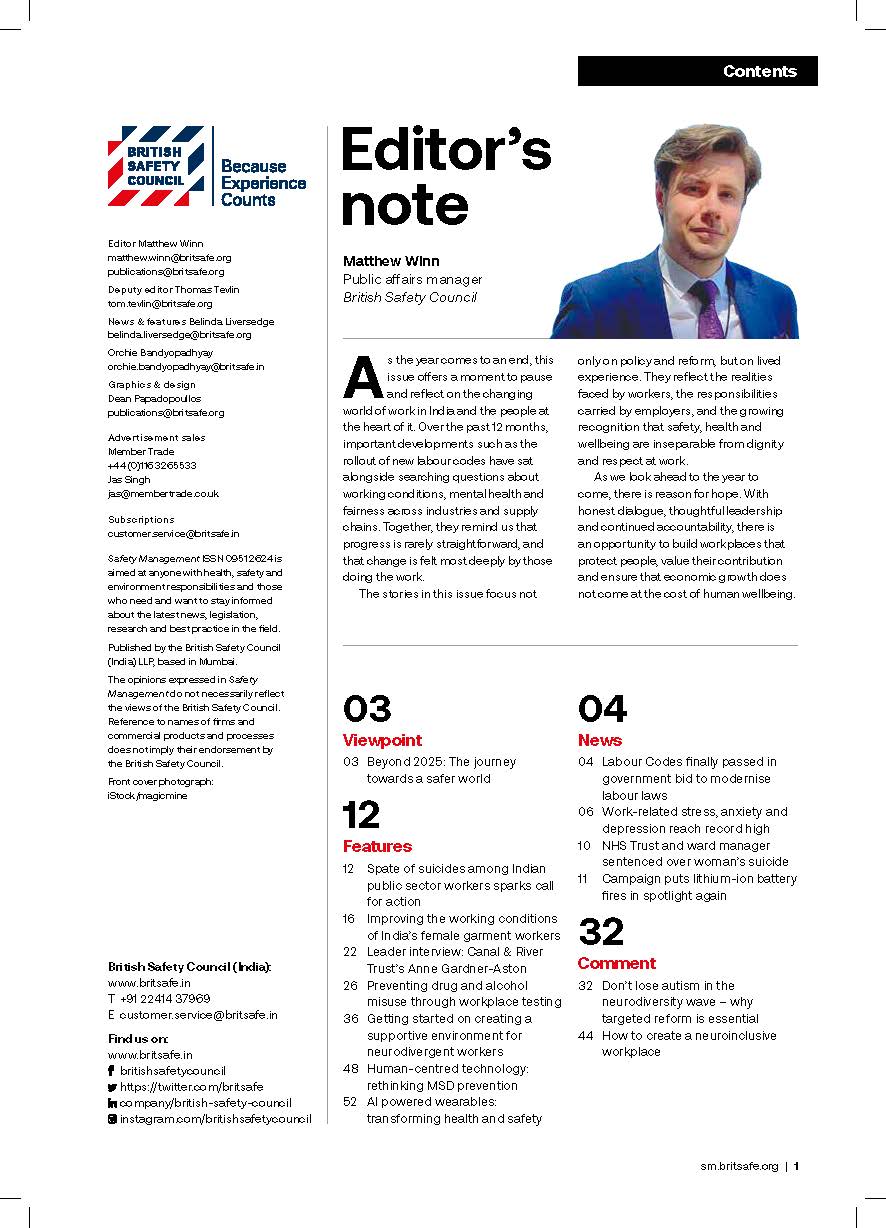The regulatory landscape covering fire safety arrangements and structural features in domestic and commercial buildings has undergone a number of significant changes in recent years, making it essential for responsible persons to review their approach to keeping residents, workers and the nearby public safe from the risk of fire.
Features
2025 UK fire safety regulation updates: a quick guide
The state of play regarding fire safety regulations in the UK is expected to continue evolving in 2025. Last year saw huge developments largely driven by the aftermath of the Grenfell Tower tragedy, the inquiry that followed and the lessons that should be learned in its aftermath.
It has led to a concerted effort to improve duty holder awareness of long-term building stability and ensure greater public safety. Whether you’re responsible for health and safety in domestic or commercial dwellings, understanding the most current and up-to-date UK fire safety regulations is pivotal.
Staying informed of any changes is vital for maintaining compliance and ensuring that each building under your watch is best equipped to handle fires and ensure the health and safety of all who come through it.
 The updated BS 9991:2024 Fire Safety Standard specifies fire safety requirements for the design, management and use of residential buildings. Photograph: iStock
The updated BS 9991:2024 Fire Safety Standard specifies fire safety requirements for the design, management and use of residential buildings. Photograph: iStock
UK fire safety law changes in 2025
Updated fire safety standards
One of the most significant changes involves the phased withdrawal of BS 476 fire testing standards, which are crucial for ensuring building safety in the UK. This set of standards was once the national classification for test methods to assess how building materials and structures react to fires and their fire-resistance (i.e. how materials ignite and spread fire and how long a structure can withstand a fire). However, it will now make way for the more comprehensive BS EN 13501 European classification system.
This transition, which commenced in March 2025, aims to align UK standards with recognised European protocols, providing more comprehensive performance classifications and covering a broader range of fire types. The introduction of the new European standards is of great relevance to architects, construction contractors and property owners, who are responsible for ensuring that materials and structures used in buildings meet the appropriate fire safety standards.
Additionally, the fire safety considerations that must be taken into account for the common and ancillary areas of residential premises have been revised and strengthened following the release of the updated BS 9991:2024 Fire Safety Standard.
This standard specifies fire safety requirements for the design, management and use of residential buildings (such as apartment blocks and student housing), with the aim of ensuring an adequate degree of life safety is achieved in the event of a fire in these buildings. It is also designed to ensure that the building’s fire safety design features are sufficient to ensure an appropriate level of safety protection for property and businesses located near the building in question.
The scope of BS 9991:2024 has been extended to include residential care homes, and now sets specific provisions designed to address the unique fire safety risks to vulnerable residents in these buildings. More general changes, applying to all relevant buildings, include clearer height limits for single-staircase buildings, detailed evacuation lift recommendations for tall buildings and revised building height limits for the installation of sprinkler systems.
 Choose compliant and compatible fire protection components and systems when upgrades are necessary. Photograph: iStock
Choose compliant and compatible fire protection components and systems when upgrades are necessary. Photograph: iStock
The various updates to BS 9991:2024 mean duty holders for residential buildings – such as architects, building designers, contractors and fire risk assessors – now face a variety of additional challenges when ensuring compliance with the design, management and use of fire safety features and arrangements for residential buildings. This means duty holders will need to take a pre-emptive approach to meet the new design and building regulation challenges they face for residential buildings under their control.
Safety professionals should therefore review the existing and updated fire safety specifications affecting existing and planned residential premises under their control, and ensure they, along with their suppliers, understand the new requirements outlined by BS EN 13501 and BS 9991:2024 – especially when procuring fire protection systems and their associated products.
Mandatory fire sprinkler systems in care homes
As mentioned, new regulations mandate that all newly built care homes install professional, approved fire sprinkler systems irrespective of building height. This follows increased scrutiny by industry professionals to ensure that building managers understand and recognise the vulnerability of care home residents and how fire safety in such facilities should not be overlooked.
This doesn’t just apply to new builds but also facilities that are in the process of or have undergone major renovations or refurbishments.
Facility managers overseeing these developments must factor in fire sprinkler installation costs and ongoing maintenance requirements. Specialist UK firms like Applications Engineering, a leading supplier of precision components for fire protection systems, report common misunderstandings of fire sprinkler systems among duty holders. As a result, they are seeing increased demand for intricate products like flow switches, pressure sensors and other components that keep a sprinkler system in perfect working order.
Updates to personal emergency evacuation plans (PEEPs)
Another significant fire safety improvement covers the introduction of comprehensive PEEPs for occupants of residential buildings. PEEPs are customised escape plans for individuals who need assistance to evacuate a building safely during an emergency, such as people with disabilities, impairments or temporary health conditions that might hinder their ability to evacuate without help.
The requirement for more comprehensive PEEPs for occupants of residential buildings represents an advancement in evacuation planning, particularly for people living in high-rise residential buildings – or residents of buildings between 11 and 18 metres high – where collective evacuation strategies are already required and enforced. Unlike workplace PEEPs, these residential plans must address the specific challenges of evacuating older residents, or those with disabilities or mobility limitations.
Safety professionals working in mixed-use developments or for assisted housing providers must understand the UK’s PEEP requirements in 2025. The policy now mandates a five-step identification process for vulnerable residents and for appointed ‘Responsible Persons’ to develop bespoke evacuation strategies for these at-risk individuals, which must be co-ordinated with local fire and rescue services. This development was in response to the UK Government’s Emergency Evacuation Information Sharing Plus (EEIS+) consultation.
Other emerging risks: lithium-ion batteries
As electric vehicles and bikes (e-bikes) have grown in popularity, it has brought with them increased attention to new fire risks. A Private Member’s Bill from Liberal Democrat peer Lord Redesdale (which, at the time of writing, is currently progressing through Parliament) seeks to regulate the online sales and storage of lithium-ion batteries prevalent in these vehicles and bicycles. As there has been an increase in domestic fires due to these batteries, there have been increasing calls for stricter regulations around their sale, use and storage.
For building safety managers, this emerging risk requires a proactive and methodical assessment of car parks, bicycle storage areas, charging points and other communal rooms where lithium-ion batteries could be present, and may be charged. Risk mitigation strategies must be developed to ensure these vehicle and e-bicycle batteries do not pose an undue fire or safety risk to nearby vehicles, buildings or people. Duty holders responsible for locations where there are increased fire risks from lithium-ion batteries are increasingly specifying passive fire protection systems to mitigate the risk, according to providers of such systems.
A quick summary of the Labour Government’s Remediation Acceleration Plan
The Westminster Government’s Remediation Acceleration Plan for increasing the pace of remediation of residential buildings with unsafe cladding in England has been met with optimism, despite its ambitious targets to remove all unsafe cladding from certain residential buildings in England by 2030.
The plan sets out timeframes and steps to remove dangerous cladding from buildings above a certain height by 2030.
The Government’s target is that buildings above 18 metres (that are part of government-funded remediation schemes) must have unsafe cladding removed by the end of 2029, while buildings above 11 metres must either be remediated by the same deadline or set realistic completion dates for the required measures, or the landlords will be liable for ‘severe penalties’, according to the Ministry of Housing, Communities and Local Government.
This accelerated timeline is likely to place a strain on the capacity of remediation contractors and the availability of remediation materials, as well as on costs. What’s more, there is ambiguity around specific roles in the remediation process and repercussions for those duty holders who fail to meet the required deadlines. In particular, landlords who don’t meet the specified deadlines risk being hit with penalties and fines, while Responsible Persons under the Fire Safety Order don’t have much clarity on the definition of their duties. However, it’s expected that these issues will be clarified and expanded upon later this year.
Key takeaways: what do safety professionals need to know?
In light of these new regulation updates, building safety professionals and facility managers must:
- Conduct thorough audits of existing fire protection systems and evacuation procedures
- Ensure all fire safety documentation reflects current regulatory requirements
Engage with specialist fire safety contractors and consultants to identify compliance gaps - Deploy robust training programmes for all relevant personnel to ensure the building inhabitants’ safety
- Familiarise themselves with the technical aspects of BS EN 13501 classifications and how to transition from BS 476 standards
- Choose compliant and compatible fire protection components and systems when upgrades are necessary
- Revisit supplier relationships to ensure that products can be readily available during emergencies.
Those who adapt quickly to the new requirements will be better positioned to protect building occupants while managing compliance costs effectively. Regular consultation with fire safety specialists and ongoing professional development will be essential for navigating these complex changes successfully.
Chloe Miller is a business graduate and freelance writer, who writes about industry insights and latest best practices. She specialises in marketing, business and HR content. Contact her at:
chloe-miller.co.uk
E. [email protected]
FEATURES

The price of fast fashion is not pretty
By Orchie Bandyopadhyay on 11 December 2025
The largely female workforce in India’s garment manufacturing industry faces long hours, low wages and poor working conditions, and campaigners say it is time the Indian government and international clothing brands took tougher action to improve working conditions, pay and employment rights.

Suicide at work: a major problem in India
By Orchie Bandyopadhyay on 11 December 2025
Recent reports of suicides among workers ranging from police officers to electoral roll officials have prompted calls for employers and government agencies to do more to both reduce excessive workloads and provide better mental health support at work.



